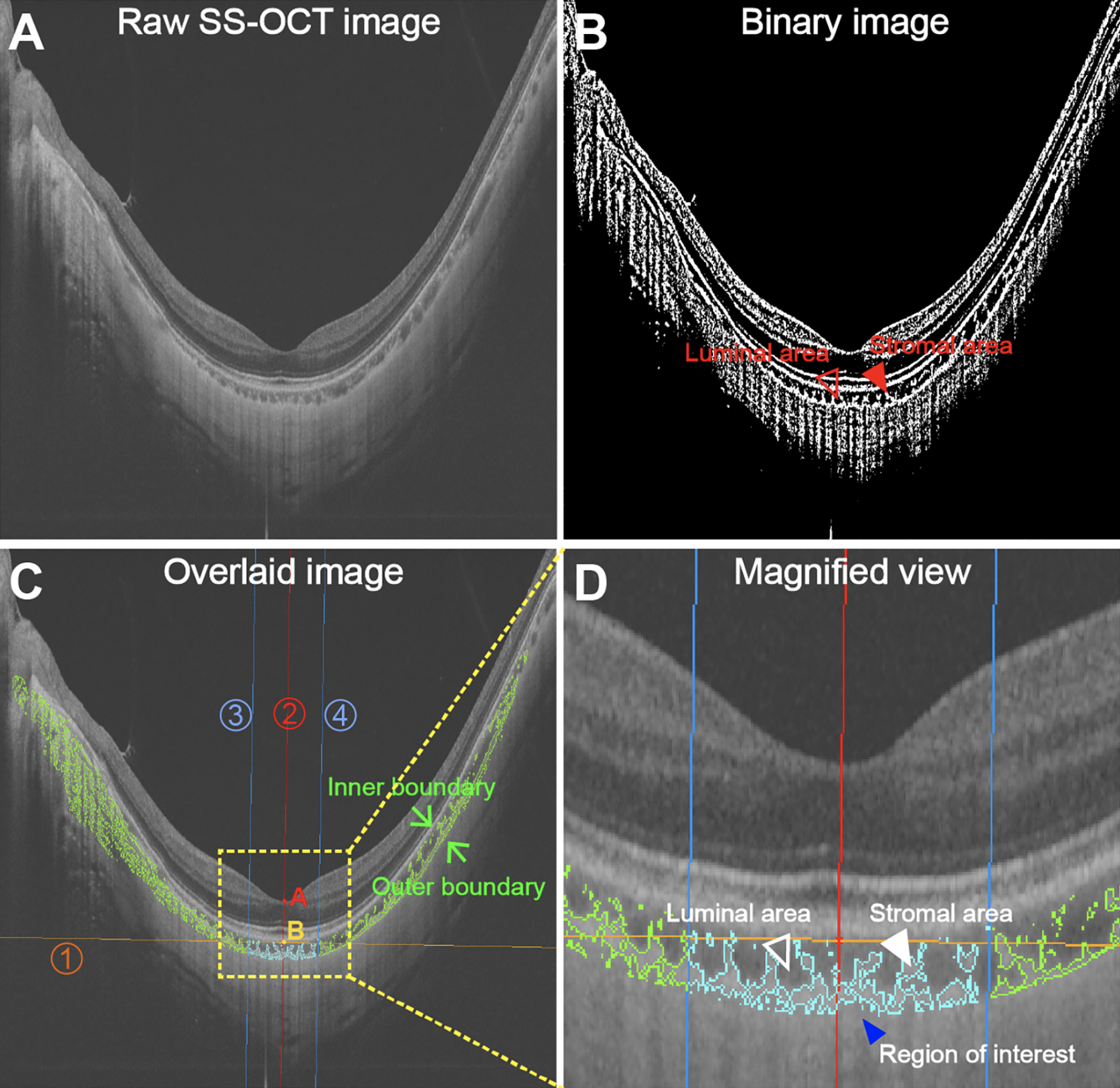 |
|
For every 10-μm increase in subfoveal choroidal thickness and each 1% increase in choroidal vascularity index, this study noted an associated decrease in axial length elongation of 0.007mm and 0.010mm, respectively. This image from the study shows (A) raw SS-OCT image, (B) converted binary image with luminal area and stromal area indicated, (C) annotations of foveal center at point A and the choroidal inner boundary closest to the fovea center at point B, and (D) Aamagnified view of the choroid in the foveal region. The 1500μm-wide choroidal region of interest is indicated by a blue arrowhead, the choroidal luminal area is indicated by an empty arrowhead and the choroidal stromal area is labeled by a closed white arrowhead. Photo: Xuan M, et al. Invest Ophthalmol Vis Sci. 2024;65(10):7. Click image to enlarge. |
Highly myopic eyes have a significantly thinner choroid and compromised choroidal circulation compared to normal eyes. While it’s known that the choroid undergoes mechanical stretching and thinning due to axial elongation of the globe, emerging research now suggests that the choroid plays a role in emmetropization and myopic progression. One recent study observed a decrease in subfoveal choroidal thickness (SFCT) in children with myopia experiencing rapid refractive progression.
Adding to the evidence connecting choroidal thickness and myopic progression, researchers recently performed a prospective, longitudinal, observational study that demonstrated an association between a thinner choroid and increased axial length elongation over two years in children with high myopia. The study included 163 participants ages eight to 18 years with bilateral high myopia (sphere ≤-6.0D) and without pathologic myopia. The mean age of the cohort at baseline was 15 years old and 47% was male. Throughout the two-year follow-up period, patients underwent ocular examinations including SS-OCT and axial length measurements. To assess the structure of the choroid, SFCT and choroidal vascularity index (CVI) were derived from SS-OCT scans using a deep-learning–based program.
The findings revealed an inverse relationship between axial length elongation and increases in baseline age, baseline SFCT and CVI, as well as a decrease in baseline axial length. The researchers reported in their paper, recently published in Investigative Ophthalmology & Visual Science, that after adjusting for potential baseline risk factors such as age, gender and initial axial length, “every 10-μm increase in SFCT and each 1% increase in CVI were associated with decreases in axial length elongation of 0.007mm and 0.010mm, respectively.” They also noted that including SFCT or CVI in predictive models for axial length elongation improved discrimination over models that use only age, gender and baseline axial length.
While previous literature has also demonstrated that highly myopic eyes exhibit a significantly thinner choroid compared to normal eyes, this study is the first to present longitudinal evidence that “a thinner choroidal thickness at baseline is predictive of greater axial length elongation in children with high myopia,” the authors pointed out in their paper. “Furthermore,” they continued, “a lower CVI might be associated with greater axial length elongation.”
The authors caution at the conclusion of their paper that further studies with larger cohorts are needed to confirm these findings, which “underscore the significance of choroidal thickness and circulation in the process of axial length elongation.”
Xuan M, Wang D, Xiao O, et al. Choroidal vascularity and axial length elongation in highly myopic children: a 2-year longitudinal investigation. Invest Ophthalmol Vis Sci. 2024;65(10):7. |


